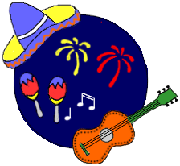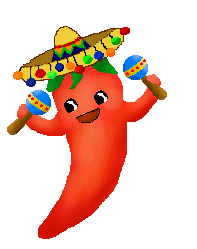  
Cinco
de Mayo |
What is Cinco de Mayo?
The holiday of Cinco De Mayo, The 5th Of May,
commemorates the victory of the Mexicans over the French army at The
Battle Of Puebla in 1862. It is primarily a regional holiday celebrated in
the Mexican state capital city of Puebla and throughout the state of
Puebla, but is also celebrated in other parts of the country and in
U.S.cities with a significant Mexican population. It is not, as many
people think, Mexico's
Independence Day, which is actually September 16.
For the most part, the holiday of Cinco de Mayo
is more of a regional holiday in Mexico, celebrated most vigorously in the
state of Puebla. Though there is recognition of the holiday throughout the
country with different levels of enthusiasm, it's nothing like that found
in Puebla.
Celebrating Cinco de Mayo has become increasingly popular along the
U.S.-Mexico border and in parts of the U.S. that have a high population of
people with a Mexican heritage. In these areas the holiday is a
celebration of Mexican culture, of food, music, beverage and customs
unique to Mexico.
Commercial interests in the United States and Mexico have also been
successful in promoting the holiday, with products and services focused on
Mexican food, beverages and festivities, with music playing a more visible
role as well. Several cities throughout the U.S. hold parades and concerts
during the week following up to May 5th, so that Cinco de Mayo is becoming
a bigger holiday north of the border than to the south, and adopted into
the holiday calendar of more and more people every year.
[Sources: Encyclopedia Encarta, Encyclopedia Britannica,
Prescott's Mexico:1900, HistoryChannel.com, other sources. Updated May,
2004]
|
Objectives:
* Students will recognize that countries have
celebrations unique to them.
* Students will know why Cinco de Mayo is recognized
as a national holiday in Mexico.
* Students will be able to recall facts from the
events on May 5, 1862.
* Students will compare and contrast the opposing
viewpoints of the Mexican and French sides.
* Students will identify three celebration activities
participated in during Cinco de Mayo and
understand their significance.
* Students will recognize that the United States, and
the world, are made up of cultures other than their own.
* Students will recognize and be able to use various
common Spanish words.
Time Required:

1 week
Vocabulary:
| sombrero |
| fiesta |
| flores |
| cinco |
| Mayo |
| puebla |
| Hola |
| Adios |
| verde |
| rojo |
| blanco |
| bailar |
| comer |
| amigo |
| guerra |
| si |
| celebracion |
| ?Como estas? |
| Muy bien |
| Por favor |
| Gracias |
| De nada |
| musica |
| fuegos artificiales |
Materials:
*maps (World, U.S.,
Mexico)
* tortilla ingredients
* materials for sombreros
* materials for paper flowers
* beans, paper bags, and streamers for maracas
* Fiesta Mexicana tape
* pinata
* parent letter
* member of a mariachi band
* yarn
Procedures:
A.
Ask students to brainstorm some holidays with
which they are familiar and the activities that accompany these celebrations.
Ask students if they know why we celebrate these holidays in the way we do
(e.g., dyeing Easter eggs, and hanging stockings).
Ask students if they know of
any other holidays that they may not celebrate but have heard of.
List as many
holidays as the class can come up with on the board.
Brainstorming
Tips
B.
Start a K-W-L chart on butcher paper in front of the
class.
Ask students what they already know about Cinco de Mayo and what
they want to know.
Have students start individual charts as well. Explain
to them that they may use the things on the butcher paper and their own ideas.
Tell them that every time they learn something new relating to Cinco de
Mayo they should record it on their chart.
K-W-L
Printable Chart
C.
Explain to students that all countries have
celebrations unique to them.
Tell children that they will be learning all about
the Mexican holiday Cinco de Mayo.
Ask if anyone has heard of Cinco de Mayo. (If
someone has, have them share it with the class.)
Ask if anyone knows what the
words "Cinco de Mayo" mean in English.
Provide children with
information about the holiday (e.g., what it is, when it is, what it is a
celebration of, etc.). Cinco
de Mayo History
Give children a visual representation of the ratio of
French army to the Mexican peasants by calling six students up into one side and
then two on the other side.
Ask students if they think this ratio is equivalent
and fair.
Show children Mexico, France, England, and Spain on a world map. On a
map of Mexico, show children the town of Pueblo.
On a U.S.
map, identify areas
in which many of the citizens are of Mexican ancestry. (California, Arizona,
Texas, New Mexico, Florida, New York.) Write these on the board.
D.
Read Fiesta! to the children
focusing their attention on the different activities the people are
participating in, and the emotions the people seem to be feeling.
Encourage
students to discuss the book aloud after it's read to them.
Have students write
a list comparing and contrasting the similarities and differences of Cinco de
Mayo celebrations with our Thanksgiving or Fourth of July celebrations.
See if
students can figure out why Thanksgiving and the Fourth of July were the
holidays chosen to compare Cinco de Mayo to (e.g. these are celebrations of
thanks and pride in our country.)
E.
Divide students into groups of five or six
and then number off in groups.
Give students papers with 5-6 questions on them
relating to the Battle of Puebla. Tell the students to work together so everyone
knows the answers and can explain them.
Give the students time to work on the
questions. Then call out a number and the student with that number will answer
for the team orally. One person from each group will get to answer each time.
The class will discuss each groups answer. (Question
Samples.)
F.
Teach children some Spanish words relating to
Cinco de Mayo.
Talk about cognates. Write these words up on a piece of butcher
paper in front of the class.
Practice pronunciation and learn the meanings.
Provide students with a list of these words.
Have students pair up and practice
pronouncing these words and using them (or inserting) them into English
sentences. (e.g., "You are a good amigo.")
Students can quiz
each other for meaning as well. Tell children to be looking for new Spanish
words all week as they're learning to add to the list.
(Spanish Words.)
G.
Have students write in their journals.
Choices:
1) write a story using their new Spanish vocabulary words,
2) write as if they
are Mexican peasants before or after the battle--what are they feeling and
doing, or
3) write about three of the activities that are included in the
celebration of Cinco de Mayo and why these activities are done. (Eventually all
students will write on all topics.)
H.
Remind students that pinatas are a big part of the
celebration of Cinco de Mayo.
Explain to students that pinatas originated in
Italy and by the middle of the sixteenth century, the idea of the pinata (and
many other Italian ideas and customes) had filtered into other countries such as
Spain.
In Spain the pinata began to be used for religious purposes such as the
first Sunday of Lent. The breaking of the pinata was a very somber occasion. The
Spanish explorers eventually carried the pinata to Mexico nearly 400 years ago.
The pinata in Mexico continued to have religious significance but it was used
for happy occasions as well (mostly at Christmas).
Besides this difference,
pinatas in Mexico began to be elaborately decorated unlike in the past.
Eventually, pinatas were used for all festive occasions in Mexico and around the
world.
Their use has come to signify warmth, friendliness, and festiveness.
Divide students into groups of 5 or 6. Explain that each group will be making a
pinata for themselves to hit at during our culminating activity.
(Pinata instructions.)
I.
Vive la fiesta! Students will participate in a
classroom fiesta. The room will be divided up into centers that each child will
have a chance to go to. Centers will include the following activities:
Tortilla making/Tortilla eating contest
Making tissue paper flowers
Learning the "Raspa"
Listening to a real mariachi band member (if possible)
Making and decorating maracas (Beans in paper bags and decorate)
Making sombreros
Breaking the piñatas (groups from the day before will break their own.)
Evaluation:
Section regarding Cinco de Mayo in students journals will be assessed
Responses to discussion questions will be assessed
Responses to "guided discussion" and "corners" activities
will be assessed
Individual K-W-L charts will be assessed
Students comparisons of holidays will be assessed
One page student summary will be assessed
Extension Activities:
1) Invite a native Mexican to talk to the class about his/her
celebration customs for Cinco de Mayo.
2) Have students get in small groups and reenact the Battle of Puebla.
3) Have students make up their own variation to the Raspa.
4) Play concentration and bingo with Spanish word cards.
5) Write a class book about Cinco de Mayo.
6) Tell students that Benito Juarez has been called the "Abraham Lincoln of
Mexico." Have them write a paragraph explaining why.
7) Build a topographical map of Mexico to explore its diverse land of deserts,
mountains,
peninsulas, etc.
Home Learning:
At the end of the fiesta, students will be asked to write a one page paper
summarizing all that they have learned during the our Cinco de Mayo week.
Complete Cinco de Mayo
Webquest

Home |